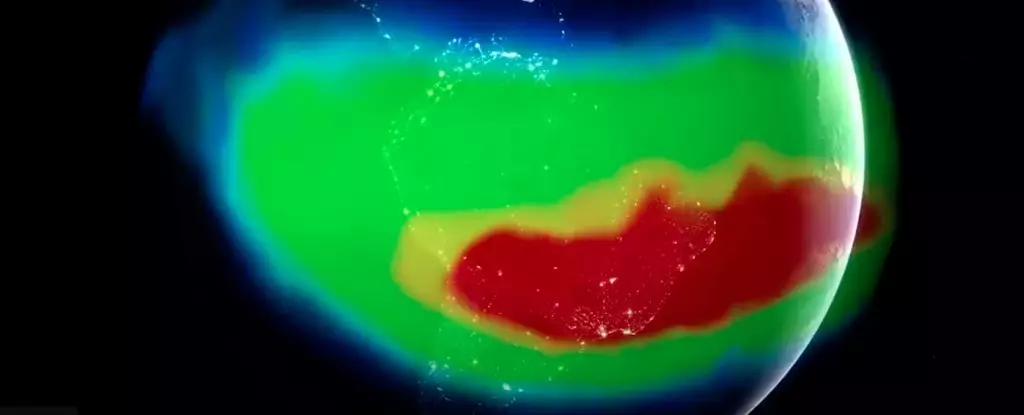Earth’s magnetic shield functions as an invisible guardian, deflecting solar radiation and charged particles that originate from the Sun. Yet, within this protective cocoon lies a puzzling region known as the South Atlantic Anomaly (SAA). For decades, scientists have observed a significant dip in magnetic field strength stretching between South America and southwestern Africa. While it may seem like an obscure geographic oddity, the SAA embodies a profound mystery, hinting at the complex dynamics of Earth’s inner core and its magnetic architecture.
This area doesn’t threaten life on the surface directly—thanks to the atmosphere absorbing most harmful solar radiation—but it poses a serious concern for our technological infrastructure orbiting within Earth’s near-space environment. Satellites, space stations, and other spacecraft are exposed to heightened risks as they pass through this weakened magnetic zone. The vulnerabilities they face are not trivial; high-energy protons from the Sun can disrupt or permanently damage sensitive electronics, causing data loss or even catastrophic system failures. For NASA and other space agencies, monitoring the SAA isn’t just about safeguarding assets; it is about understanding a geological phenomenon that could unlock clues about the planet’s interior and magnetic evolution.
Deciphering the Origins: Inner Earth’s Secrets and Magnetic Mysteries
To comprehend the SAA, one must peer beneath Earth’s surface into its molten core, where the forces shaping our magnetic environment originate. The core is predominantly composed of liquid iron, churning relentlessly and generating electrical currents that produce Earth’s magnetic field—a process known as the geodynamo. Yet, this magnetic field is far from uniform. Variations and irregularities emerge, particularly in regions such as the African Large Low Shear Velocity Province—a dense, sluggish zone deep beneath the Earth’s crust.
Scientists like NASA geophysicist Terry Sabaka suggest that these complex internal processes create superimposed magnetic fields, combining to form the anomalies we observe at the surface. The weakening zone in the SAA is associated with the presence of localized reverse polarity fields—regions where magnetic poles flip directions compared to the global field. These localized reversals cause the familiar ‘dent’ or ‘pothole’ in Earth’s magnetic shield, diminishing its protective strength and allowing more solar particles to penetrate.
This insight is not just academic curiosity—it challenges assumptions about the stability of Earth’s magnetic poles and the long-term behavior of our planet’s geomagnetic field. The anomaly’s existence implies that Earth’s magnetic shield is more dynamic and mutable than previously thought, exhibiting slow but persistent shifts that could have broader planetary implications.
The Dynamic Nature of the Anomaly: Drift, Division, and Long-Term Patterns
Contrary to earlier beliefs that the South Atlantic Anomaly was a static feature, recent research illustrates a landscape in constant flux. Data from NASA’s CubeSats and global satellite systems reveal that the SAA is not only drifting westward but also showing signs of split formation. In 2020, scientists detected the emergence of two distinct centers within the anomaly—a phenomenon known as ‘division.’ This bifurcation suggests that the magnetic weakness is evolving into more complex structures, potentially influencing future geomagnetic behavior.
What makes this divergence so captivating is the implication that the SAA might be part of a longer, cyclical pattern rather than an anomaly born anew each time. A study from 2020 proposed that similar magnetic features have persisted for millions of years, dating back at least 11 million years. If these patterns are recurrent, it accentuates the idea that the Earth’s magnetic field undergoes significant, yet predictable, oscillations over geological time scales.
Crucially, the ongoing study of the SAA might provide vital insights into the fundamental processes steering geomagnetic reversals—phenomena where the Earth’s magnetic poles swap places entirely—events linked to magnetic field fluctuations but not necessarily immediate triggers. Such understanding could reshape our perception of Earth’s long-term magnetic future, including the potential for pole flips and their impacts on global climate and navigation systems.
The Implications and Urgent Need for Continued Observation
While the SAA appears as a localized weakness, its broader implications ripple through space weather forecasting, satellite technology, and planetary science. Its slow movement, but apparent morphological change, emphasizes the importance of continuous monitoring. NASA’s dedicated missions act as our eyes and ears in orbit, revealing that even a “despised pothole in space” is an extraordinary window into Earth’s internal dynamics.
The anomaly’s persistent evolution hints at the fact that our planet’s magnetic shield is an active, shifting entity—one that responds intricately to deep-seated geophysical forces. Understanding these forces is not just a matter for academic discourse but fundamental for safeguarding human technology and understanding Earth’s future stability. The potential division of the SAA into multiple segments raises questions about the stability of the global magnetic field and whether we are witnessing early signs of a larger reconfiguration—a precursor to more dramatic magnetic shifts.
In essence, the South Atlantic Anomaly reminds us that Earth’s interior is anything but static. It embodies the complexity, dynamism, and interconnectedness of our planet’s geophysical systems. As NASA and other scientific bodies continue to scrutinize this phenomenon, the hope remains that unraveling these mysteries will provide foresight into Earth’s magnetic behaviors and perhaps insight into the planet’s long-term evolutionary trajectory.


Leave a Reply